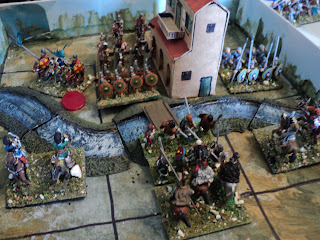'The second year of Michael Ponos, Emperor, was a year of constant pressure from without the Byzantine Imperium, and revolt within. The armies, provincial and imperial both, found themselves constantly on the march, when they were not in action, withal. In the early spring of 998, a considerable Bulgar raiding party, led by the local kavkhan, Attishu, made an attack across the river Potomos in an attempt to seize the border village of Hapax. This place being a border market town, wherein met every day peoples from both sides of the water, this was to be the lucrative beginning of what was hoped by the Bulgars to be a profitable foray. The ultimate aim was the rich town of Tetrakis, several miles inside Byzantine territories.
Pakourianos Dryos, the local commandant Hapax and its hinterland, had heard rumours of Bulgar preparations for the attack, and prepared according to the resources available to him. He resolved in the first instance to oppose the river crossing at Hapax itself. For all his determination, he still apprehended the small size of his force that he could bring against the Scythian* hordes...'
Michael Psellophanes, Byzantiad.
1. The battleboard maps:
 |
| Maps 1 and 2 |
 |
| Maps 3 and 4 |
 |
| Maps 5 and 6 |
3. The composition of the raiders' force is constant:
- Commander, Kavkhan Attishu (who may be replaced if killed)
- 1 noble heavy horse archer with javelins and bow (elite)
- 1 noble heavy horse archer with javelins and bow (average)
- 2 light horse archers with javelins and bow (average)
- 2 close order infantry with spear (average)
- Commander, a local commandant name of George Pithikos, or a higher commander later on.
- 1 heavy cavalry unit (kavallarioi) with lance and bow (average)
- 1 light cavalry unit (prokoursatores)with lance and bow (average)
- 1 close order infantry unit (skoutatoi) with spear and bow (average)
- 1 loose order infantry unit (peltastoi) with spear and javelins (poor).
6. For the battles in Maps 5 and 6, the Byzantines add a third heavy cavalry unit.
7. For this campaign I used Developing the Portable Wargame rule set with Mark Cordone's 'Fall of Rome' 3x3 game system.
8. All units begin with 2 Strength Points only (2SP). I did consider staying with the 'standard' Portable Wargames SP, but I tend to regard this 3x3 version as 'PW-Lite' or 'PW-Quickplay'. As such the 2SP system 'feels' about right, here, and qualitative differences among the units - weapons, training, esprit du corps etc - have to be brought out by other means. I've stayed with the PW 'standard' in this regard, but possible refinements might be considered.
Battle of Hapax
The Kavkhan's plan was with his light horse to engage the flanks in a cross river archery duel in the hope of weakening the defenders before charging across with his heavies. In the centre, he led his spearmen to storm the bridge into the town itself.

Bulgars close up to the riverbank, and a shooting war begins on the flanks. First blood to the Bulgars! Each counter represents an SP lost.
Under the cover of the prokoursatores light horse, the skoutatoi infantry entered the village and prepare the place for defence. Note that as the condition for victory is to reach the enemy baseline in at least one sector, with no possibility of being driven back as has just happened, I took that as superseding the Strength Point loss criterion. Meanwhile, although the peltastoi disintegrated, their Commandant remained in the fight, ready to lead where his presence would be most needed.

 |
| Battle of the bridge. Both sides score hits... |
Bulgars victorious! The skoutatoi were forced back, but there being no space available in the Reserve Area, they were eliminated. The Bulgars having forced the crossing all along the line, and only two Byzantine units remaining, it is not possible for them to recover all the lost ground, whichever side won the initiative at this point.
This was a pretty tough and hard-fought battle, with heavy losses on both sides, actually in favour of the Byzantines (6SP lost out of 8; Bulgars, 7 out of 12). But, although facing defeat with the fall of the Kavkhan, it ended with an undoubted Bulgar victory. Having given themselves over to a day or so sacking the town, the raiders gathered themselves together to plunge further into Imperial lands.

Awaiting them was George Pithikos, with his reconstituted command.
To be continued: Combat on the road.
* Scythian - generic Byzantine term for Asiatic hordes of just about any kind...




















Another great game! Looking forward to the next installment. I've found river crossings are often have higher casualties as well.
ReplyDeleteMark -
DeleteBoth sides' horse being armed with bows and/or javelins, there was a fair bit of preliminary twinging and twanging going on, and not a whole lot of clash of arms.
I am very tempted, you know, of adding a rule that a unit may not be destroyed by shooting: one has to get 'up close and personal' to deliver the coup de crunch. In compensation, one might consider making shooting slightly more effective when it CAN be more effective.
Maybe if shooting brought a unit down to 0SP, but it stayed on the field and fioghtable, but was automatically destroyed once contacted, though still able to fight back, requiring a '6' to hit. Sounds a little complicated. Maybe it will be worth a play test.
Cheers,
Ion